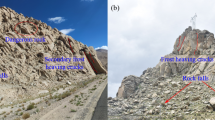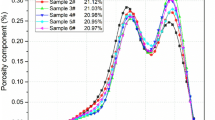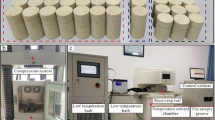Abstract
The surrounding rocks are subjected to ultralow temperatures in applications like liquid nitrogen fracturing, underground storage of liquefied natural gas and polar constructions etc. The mechanical properties of sandstone with different saturations under freezing temperature and after one ultralow temperature freeze–thaw cycle test conditions were investigated in this study. The uniaxial compressive strength (UCS) of both dry and saturated samples increases with the decrease in temperature except at − 90 °C under freezing temperature test conditions, while the UCS of saturated samples is lower than that of dry samples after one ultralow temperature freeze–thaw cycle due to the water softening effects and the damage induced during the water–ice phase transition. The failure patterns of dry samples are more complex than those of saturated samples under freezing temperature, which is also indicated in the lower brittleness index for the saturated samples. The ice cohesion effect and its creep deformation increase the plastic deformation, while decreasing the Young’s modulus of saturated samples under freezing temperature. In addition, the ice net formed in the connected pores significantly increases the sample tensile strength and makes its failure less severe. The UCS, Young’s modulus and brittleness index decrease with saturation under − 120 °C, while the tensile strength increases with saturation. Porosity reduction measured by computerized tomography for the saturated samples after one freeze–thaw cycle is largest at − 120 °C compared with those at − 60 °C and − 180 °C, which is certified by the pore filling shown in scanning electron microscope images.
Highlights
-
Tensile strength is more sensitive to the variations of subzero temperatures compared with the compression strength.
-
The cohesion and creep deformation of ice increase the plastic deformation while decrease the elastic modulus.
-
Porosity reduces after one freeze-thaw cycle due to pore filling.
-
Compression strength and brittleness index decrease while tensile strength increases with the saturation under − 120℃.
-
Failure patterns of dry samples are more complex than those of saturated samples under low temperatures.

























Similar content being viewed by others
Data availability
The experimental data can be provided upon request.
References
Arakawa M, Maeno N (1997) Mechanical strength of polycrystalline ice under uniaxial compression. Cold Reg Sci Technol 26(3):215–229
Bai Y, Shan R, Ju Y, Wu Y, Sun P, Wang Z (2020) Study on the mechanical properties and damage constitutive model of frozen weakly cemented red sandstone. Cold Regions Sci Technol 2020:171
Cai CZ, Li GS, Huang ZW, Shen ZH, Tian SC, Wei JW (2014a) Experimental study of the effect of liquid nitrogen cooling on rock pore structure. J Nat Gas Sci Eng 21:507–517
Cai CZ, Li GS, Huang ZW, Shen ZH, Wang HZ, Tian SC, Wei JW (2014b) Experiment study of rock porous structure damage under cryogenic nitrogen freezing. Rock Soil Mech 35(4):965–971
Chen TC, Yeung MR, Mori N (2004) Effect of water saturation on deterioration of welded tuff due to freeze–thaw action. Cold Reg Sci Technol 38(2–3):127–136
Chung SK, Han KC, Park ES (2006) Feasibility study of underground LNG storage system in rock cavern. Tunnel Undergr Space 16(4):296–306
Feng Q, Jiang BS, Zhang Q, Wang LP (2014) Analytical elasto-plastic solution for stress and deformation of surrounding rock in cold region tunnels. Cold Reg Sci Technol 108:59–68
Feng Q, Jin J, Zhang S, Liu W, Yang X, Li W (2022) Study on a damage model and uniaxial compression simulation method of frozen–thawed rock. Rock Mech Rock Eng 55(1):187–211
Haynes FD (1980) Temperature effect on the uniaxial strength of ice. In: International conference on port and ocean engineering under arctic conditions. Trondheim, Norway (CONF-790833)
He T, Chong ZR, Zheng J, Ju Y, Linga P (2019) LNG cold energy utilization: prospects and challenges. Energy 170(2):557–568
Huang S, Ye Y, Cui X, Cheng A, Liu G (2020) Theoretical and experimental study of the frost heaving characteristics of the saturated sandstone under low temperature. Cold Regions Sci Technol 2020:174
Inada Y, Yokota K (1984) Some studies of low temperature rock strength. Int J Rock Mech Min Sci Geomech Abstr 21(3):145–153
Ji SY, Wang AL, Su J, Yue QJ (2011) Experimental studies on elastic modulus and flexural strength of sea ice in the Bohai Sea. J Cold Regions Eng 25(4):182–195
Jia H, Liu Q, Xiang W, Zhang W, Lang L (2013) Damage evolution model of saturated sandstone under freeze–thaw cycles. Chin J Rock Mech Eng 32(S2):3049–3055
Jia H, Xiang W, Tan L, Zhang W, Zeng W, Cao S, Cheng C (2016) Theoretical analysis and experimental verifications of frost damage mechanism of sandstone. Chin J Rock Mech Eng 35(5):879–895
Jia HL, Zi F, Yang GS, Li GY, Shen YJ, Sun Q, Yang PY (2019) Influence of pore water (ice) content on the strength and deformability of frozen argillaceous siltstone. Rock Mech Rock Eng 53(2):967–974
Jia HL, Ding S, Zi F, Dong YH, Shen YJ (2020) Evolution in sandstone pore structures with freeze–thaw cycling and interpretation of damage mechanisms in saturated porous rocks. CATENA 195:104915
Kammoshida N, Okawara M, Abe M, Furuzumi M (2010) Mechanical behavior of Kimachi sandstone under ultralow temperature. J Min Mater Process Inst Jpn 127(1):8–13
Kodama J, Goto T, Fujii Y, Hagan P (2013) The effects of water content, temperature and loading rate on strength and failure process of frozen rocks. Int J Rock Mech Min Sci 62:1–13
Kurilko A, Novopashin M (2005) Features of low temperature effect upon strength of enclosing rock and kimberlite in the “Udachnaya” pipe. J Min Sci 41(2):119–122
Lemaitre J (1985) A continuous damage mechanics model for ductile fracture. J Eng Mater Technol 107(1):83-89
Li YP, Wang ZY (2012) Study of parameters and strength of thermal effects for granite under low temperature. Rock Soil Mech 33(2):321–325
Li ZF, Xu HF, Zhang CY (2016) Liquid nitrogen gasification fracturing technology for shale gas development. J Petrol Sci Eng 138:253–256
Liu M, Bai B, Li X (2014) Experimental studies on the short term effect of CO2 on the tensile failure of sandstone. Energy Proc 63:3357–3363
Looney B (2021) Statistical review of world energy globally consistent data on world energy markets and authoritative publications in the field of energy. Rev World Energy Data 70:8–20
Ma Z, Zhang G, Gamage RP, Zhang C (2021) Measurement of thermal expansion coefficient of rock minerals using XRD and its implications to thermal damage mechanism. IOP Conf Ser Earth Environ Sci 861(7):1
Mardoukhi A, Mardoukhi Y, Hokka M, Kuokkala V-T (2020) Effects of test temperature and low temperature thermal cycling on the dynamic tensile strength of granitic rocks. Rock Mech Rock Eng 54(1):443–454
Matsunaga I, Kuriyagawa M, Kinoshita N (1981) Mechanical properties of rock at cryogenic temperature. J Min Mater Process Inst Jpn 97:431–436
Memon KR, Mahesar AA, Ali M, Tunio AH, Mohanty US, Akhondzadeh H, Awan FUR, Iglauer S, Keshavarz A (2020) Influence of cryogenic liquid nitrogen on petro-physical characteristics of mancos shale: an experimental investigation. Energy Fuels 34(2):2160–2168
Ming F, Zhang S, Niu F, Zhou Z (2021) A study on crack damage stress and the damage constitutive model of frozen sandstone. Bull Eng Geol Env 80(9):6955–6970
Ning JG, Wang H, Zhu ZW, Sun YX (2005) Investigation of the constitutive modle of frozen soil based on meso-mechanics. J Beijing Inst Technol 2005:10
Sammis C, Biegel R (2004) Mechanics of strengthening in crystalline rock at low temperatures: a preliminary assessment. In: Proceedings of the 26th seismic research review: trends in nuclear explosion monitoring, pp 475–484
Song YQ, Liu JC, Shao ZX (2020) Experimental study on physical and mechanical properties of limestone under freezing thawing cycles. Sci Technol Eng 20(2):741–746
Tang M, Wang Z, Sun Y, Ba J (2010) Experimental study of mechanical properties of granite under low temperature. Chin J Rock Mech Eng 29(4):787–794
Ulusay R (2015) The ISRM suggested methods for rock characterization, testing and monitoring: 2007–2014. Int J Rock Mech Min Sci 46:627–634
Wan D, Zhu Z, Zhou C, Li J, Ying P, Wang M (2020) Effect of pre-existing symmetrical cracks on propagation behaviors of a blast-induced crack. Shock Vib 2020:1
Wang L, Lu Z, Shao S (2017) A composite power exponential nonlinear model of rock and soil. Chin J Rock Mech Eng 39(9):1724–1730
Wang EL, Ren ZF, Han HW (2021) Experimental study on uniaxial compre-ssive strength of ultra-low temperature frozen clay. Chin J Geotech Eng 43(10):1851–1860
Weibull W (1951) A statistical distribution function of wide applicability. J Appl Mech 18(3):293–297
Xie Q, Zhu Z, Kang G (2014) Dynamic stress–strain behavior of frozen soil: experiments and modeling. Cold Reg Sci Technol 106–107:153–160
Xu B, Li N, Li ZK, Yan N (2013) Low-temperature LPG and LNG storage caverns and related research review of rock mechanics. Chin J Rock Mech Eng 32(S2):2977–2993
Zhang D, Ranjith PG, Perera MSA (2016) The brittleness indices used in rock mechanics and their application in shale hydraulic fracturing: a review. J Petrol Sci Eng 143:158–170
Zhang D, Pathegama Gamage R, Perera M, Zhang C, Wanniarachchi W (2017) Influence of water saturation on the mechanical behaviour of low-permeability reservoir rocks. Energies 10(2):236
Zhang HM, Wang H, Zhang JF (2020) Analysis of meso-damage characteristics of freeze–thaw rock on CT scale. J Liaoning Tech Univ (nat Sci) 39(1):51–56
Zhao J, Xie M, Yu J, Zhao W (2019) Experimental study on mechanical properties and damage evolution of fractured rock under freezing-thawing action. J Eng Geol 27(6):1199–1207
Zheng GH, Xu JY, Wang P, Fang XY, Wen M (2019) Physical characteristics and degradation model of stratified sandstone under freeze–thaw cycling. Rock Soil Mech 40(02):632–641
Zhu YL, Zhang JY (1992) Constitutive relations of frozen soil in uniaxial compression. J Glaciol Geocryol 14(3):210–217
Acknowledgements
The authors would like to acknowledge the financial support from the Natural Science Foundation of Hebei Province (E2020202170), Natural Science Foundation of China (42202325, 42172306) Top Young Talents Program of Department of Education of Hebei Province (BJ2021022) and Hebei Province (No. 2020HBQZYC001).
Author information
Authors and Affiliations
Corresponding author
Ethics declarations
Conflict of interest
The authors declare that they have no known competing financial interests or personal relationships that could have appeared to influence the work reported in this paper.
Additional information
Publisher's Note
Springer Nature remains neutral with regard to jurisdictional claims in published maps and institutional affiliations.
Rights and permissions
Springer Nature or its licensor (e.g. a society or other partner) holds exclusive rights to this article under a publishing agreement with the author(s) or other rightsholder(s); author self-archiving of the accepted manuscript version of this article is solely governed by the terms of such publishing agreement and applicable law.
About this article
Cite this article
Zhang, D., Lu, G., Wu, J. et al. Effects of Ultralow Temperature and Water Saturation on the Mechanical Properties of Sandstone. Rock Mech Rock Eng 56, 3377–3397 (2023). https://doi.org/10.1007/s00603-023-03229-y
Received:
Accepted:
Published:
Issue Date:
DOI: https://doi.org/10.1007/s00603-023-03229-y




